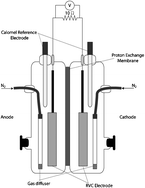This paper presents data comparing Shewanella strains acting as biocatalysts under fumarate and chromate reducing conditions in a microbial fuel cell. Catalyzing fumarate reduction, Shewanella strains show a maximum power generation of between 10.2 and 59.4 nW cm−2. Comparisons between product formation and current transfer indicate either incomplete oxidation of fumarate or utilization of a separate source of electrons. Similar comparisons under chromate reducing conditions indicate initial utilization of the electrode as the sole electron source followed by a use of an unknown reducing electron pool. Additionally, we show that fuel cell systems, with Shewanella acting as the sole biocatalysts at the cathode, are capable of achieving reduction of chromium concentrations to less than 5 ppb, well within acceptable guidelines established by regulatory agencies.

